Arsenal, Portsmouth, Tottenham Hotspur, and Mansfield Town. At the time of writing, all of those four clubs have one thing in common – they remain unbeaten in their respective leagues this season. Mansfield, currently sixth in the EFL League Two table, boast a healthy attacking output and the division’s best defensive record. Manager Nigel Clough, son of football legend Brian Clough, has been in charge of the Stags for 165 games, dating back to November 2020, but they have been somewhat stuck in League Two during that time. This season, however, they have started strong, building on their eighth-placed finish last season – many League Two fans believe Mansfield are strong promotion contenders this season.
This scout report will provide a tactical analysis of Clough’s side, highlighting the critical elements of his tactics. The analysis will provide insight into their approach on the ball, where they have shown a lot of promise yet still with room for improvement, and we will also analyse their defensive tactics as we look to uncover why they have been so difficult to beat so far this season.
High crossing rates despite having no wingers
The use of wingers is such a common factor in football, and rarely do you see a team regularly deploy a system that features no true wingers. However, Mansfield do precisely that and still find plenty of attacking success in wide areas. Not only is this a unique tactical element, but it is also vital to their system – they average 19.64 crosses per 90, the highest crossing average in League Two, quite remarkable without any wingers! So how do they achieve this? This segment explores that and examines other essential components of their attacking tactics.
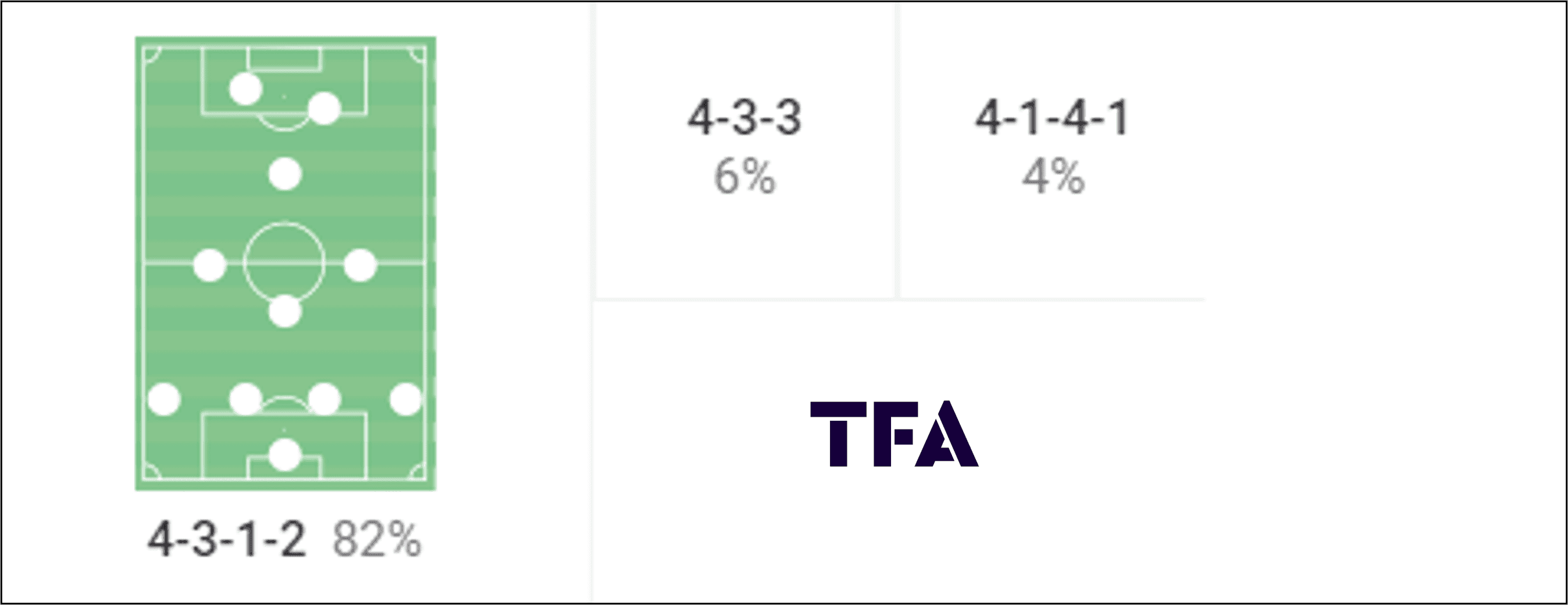
Clough has implemented a 4-3-1-2, which, on paper, looks to be a very narrow formation. And while it can be used by a team looking to play to the strengths of a narrow approach – and Mansfield do inflict their fair share of damage from central areas, their work in and out of possession allows for an excellent balance in width. In terms of attacking tactics, the full-backs are given the freedom to attack the flanks when the time is right, as you will see further on.
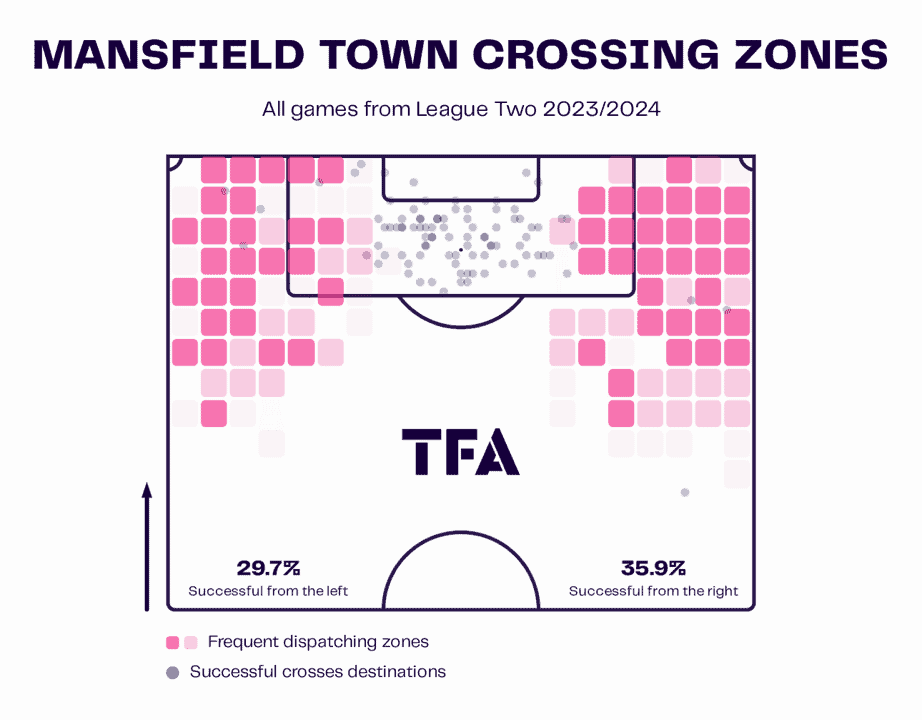
The map above tells us where they like to cross from to give a context of their crossing tendencies. They find more success in crossing from the right flank despite having hit nearly 50 crosses more from that side, which indicates a possible higher individual quality down that flank. That could also be down to crossing position – notice how they are far more likely to cross from the byline on the left flank, while from the right, they take up crossing positions closer to the centre of the box – in line with the penalty spot.
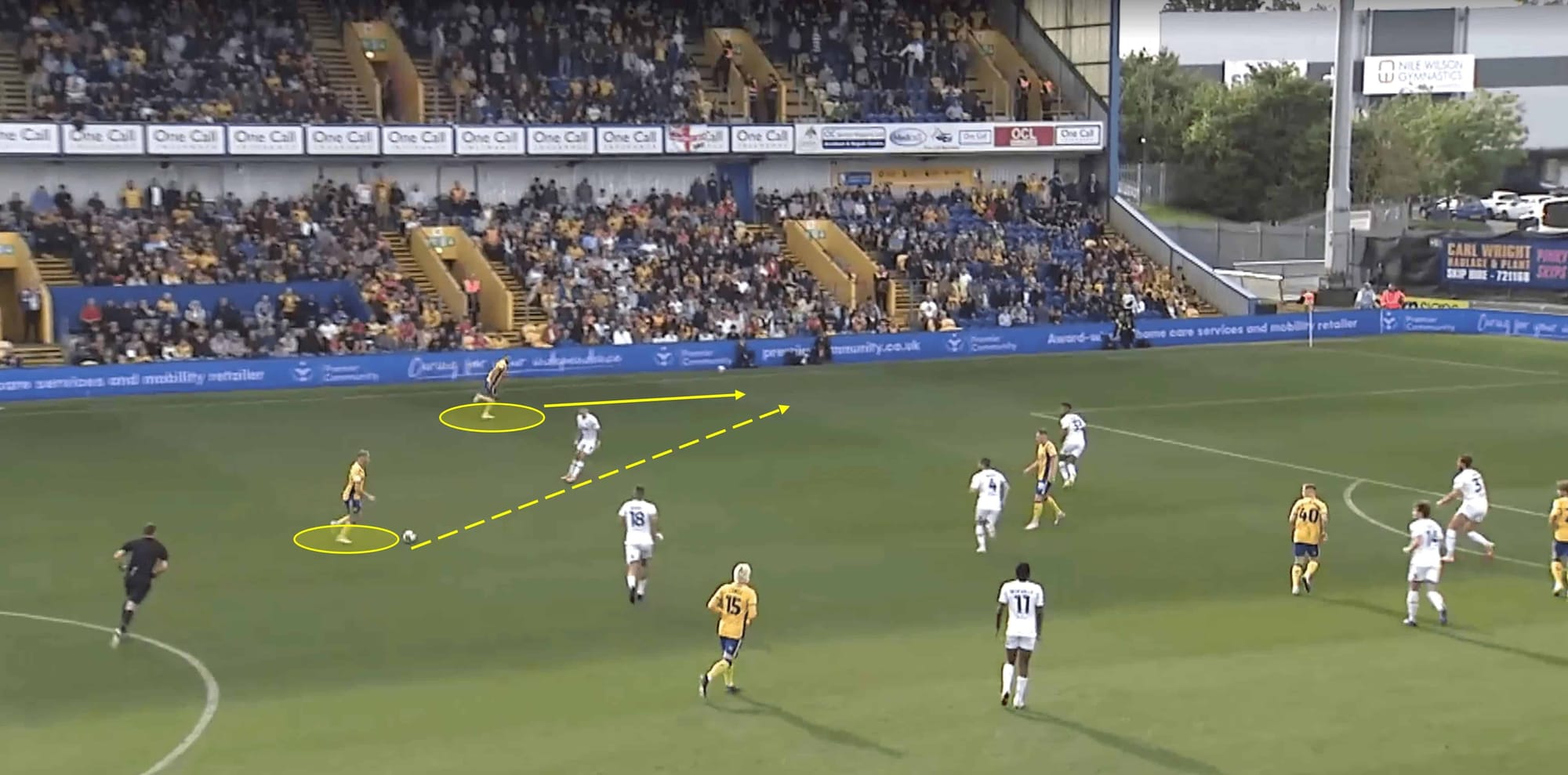
Getting into those crossing areas can happen in several ways. While you can discuss the tactics of any team all day long, individual player quality should never be forgotten about or overlooked – having quality players who can undertake several roles in their position gives a team the element of variety in their attack.
We mentioned earlier how the Stags are capable of causing damage from central areas, including building attacks from those areas, like the example above. Not only do they have possession in the middle with Louis Reed, but they have several players supporting the attack from a central area. This central presence from Mansfield causes the opposition to react and increase their own central presence, sometimes sacrificing the wide areas. In turn, this provides an opportunity for the attacking full-backs to get involved – Reed has no trouble in picking these passes out at all.
We aren’t the first to highlight Louis Reed’s ability and importance to Mansfield Town this season, but why is he so vital? Well, he is instrumental in moving the ball into the final third, as evidenced by his 12.18 passes to that area per 90 (fourth-highest in League Two), paired with an accuracy rate of 73.14%. He also has high engagement levels for progressive passes and just general passing. While Reed has some positive data to his name, you really have to watch him play to fully appreciate his ability.
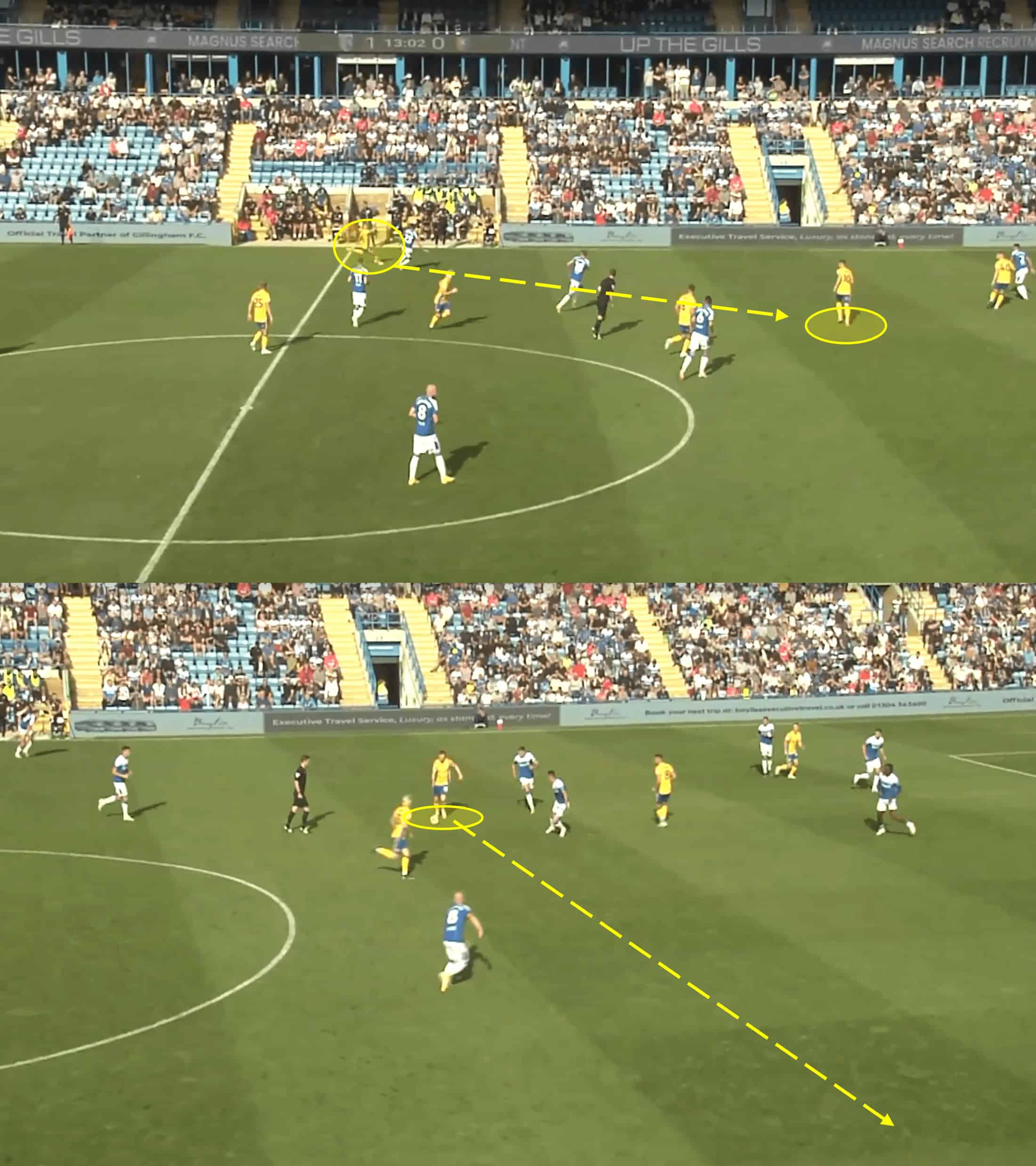
Another way Mansfield build an attack into wide areas is by gradually moving the ball from one flank to the other, again manipulating the opposition’s positioning as they did in the previous example. The ball moves into a midfield area from the left-back spot before the Stags quickly move the ball out to the opposite flank, with the full-back darting forward. Often, the opposition’s general shape is leaning toward the side of initial possession (left flank on this occasion), leaving the space on the right flank for Mansfield to attack, hence the need to move the ball quickly through the midfield third.
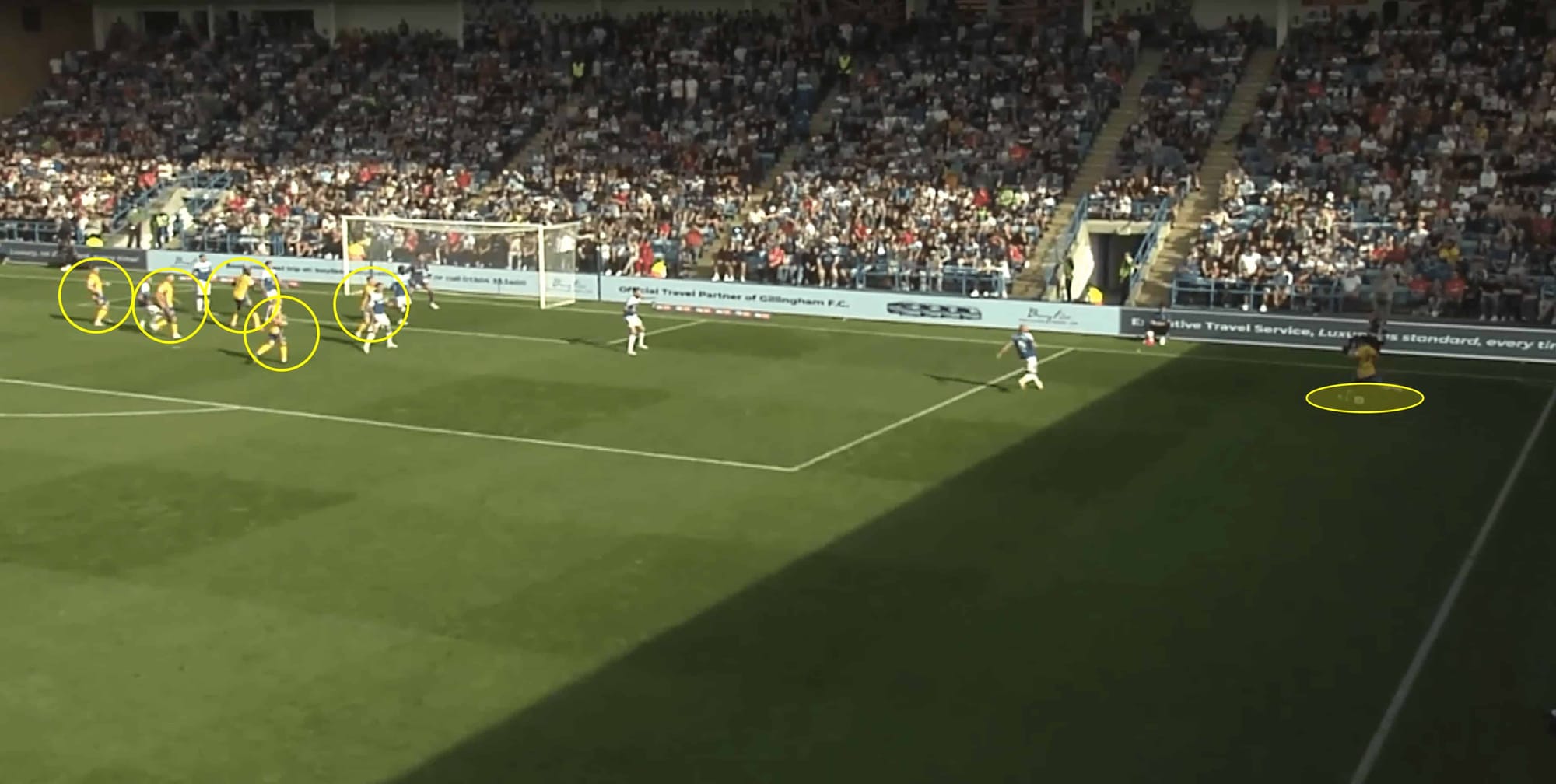
And we have established that they like to finish attacks with a cross. This is where we see the attacking intent from Mansfield, which is in part thanks to the narrow nature of their formation – they are able to flood the box with yellow shirts to add to the chaos. Interestingly, they have an accuracy rate of 33.3%, which is below the league average, so if they can finetune some of the small details in these scenarios, they will become much more dangerous in the final third.
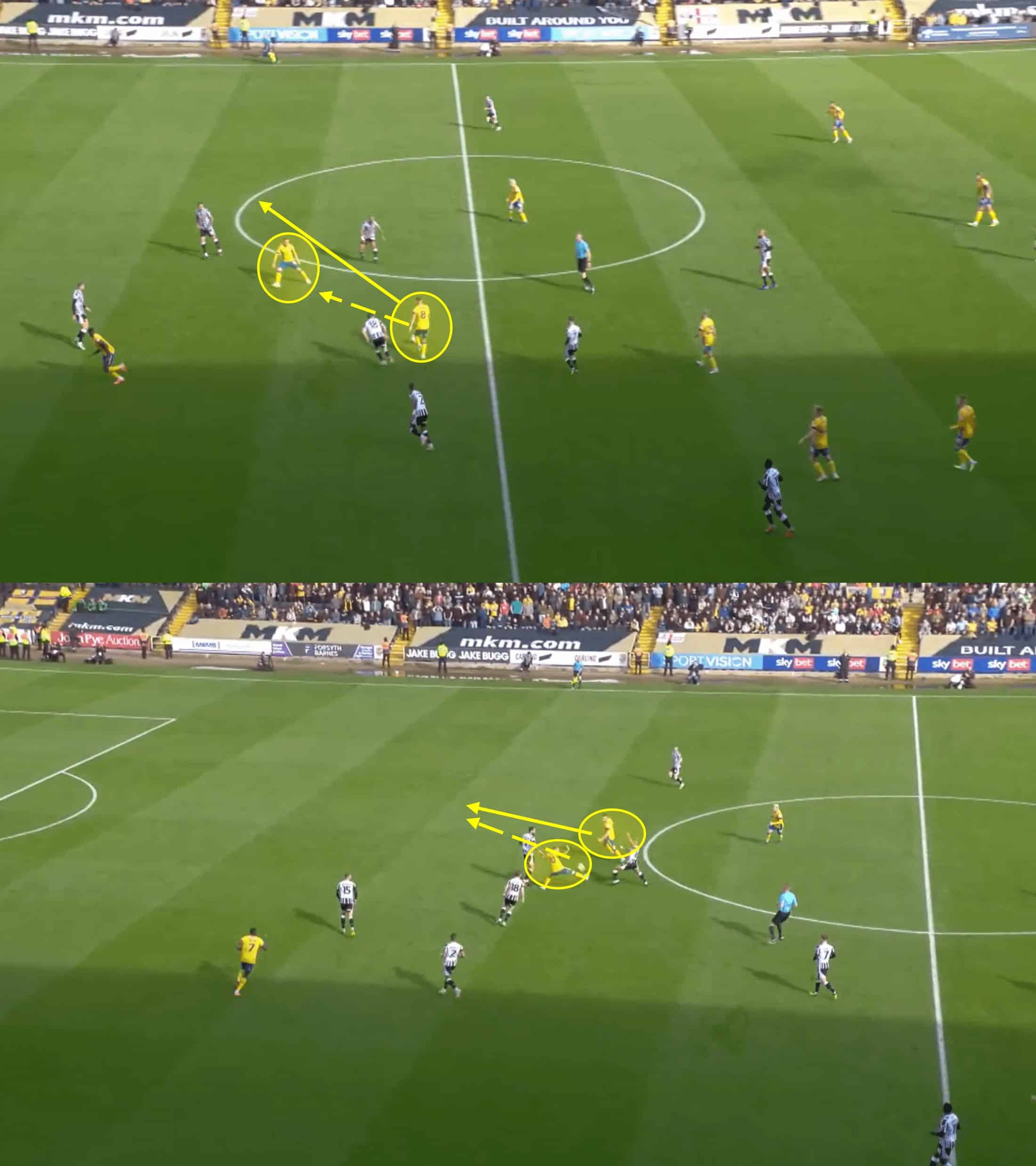
Back to their ability to hurt teams from central areas, we see more of that versatility we touched upon earlier. One of the most important (and easy on the eye) elements of their midfield in attack is how one of the midfielders will make a bursting run through the centre, often looking to break in behind the last defender. While this move is saved for times when the players think it is on, they can cause some real trouble with this attacking method, and players like David Keillor-Dunn are extremely effective in this area.
This move is likely a contributing factor in Keillor-Dunn ranking second in League Two for touches in the box per 90 (5.13) – his attacking contribution from a midfield position adds a real threat to Mansfield’s approach, and he almost always looks likely to make something happen.
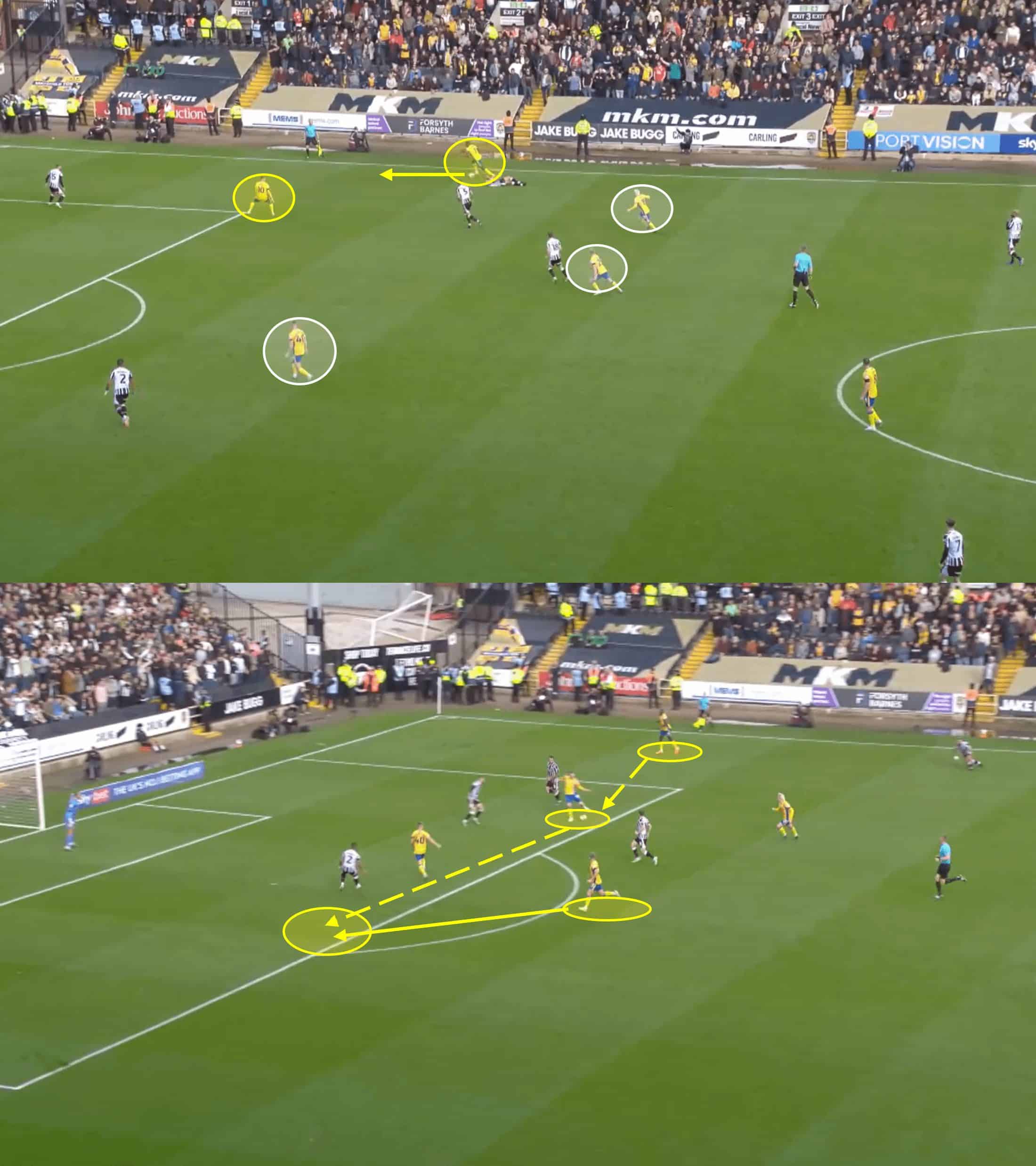
The final part of their attacking play we are going to cover in this analysis segment is their ability in attacking transitions – we will cover their actions in a press in the final analysis segment, even though their ability to hurt teams in a transition is a direct result of their pressing ability. Still, the midfield’s high starting position deserves mentioning here as it plays a huge part in Lucas Akins winning the ball on the right flank.
These transition moments are when we start to see Mansfield ramp up the pace, often using multiple passes to move the ball into a deadly area. Their work in attacking transition is a likely contributing factor to their passing rate of 14.2 (League Two’s third-highest rate). Akins wastes no time in shifting the ball to a close supporting teammate – smartly picking the easy pass instead of trying to execute a low-percentage ball into the box. The ball makes its way across the box into the path of the arriving Louis Reed, who slots the ball home – another visit from Mansfield’s tendency to use runs from midfield!
Passing variety
Mansfield have a weapon in their arsenal, not that every team does, particularly in the fourth tier, and that weapon is versatility in their approach play, particularly with their passing. While they have the third-highest passing rate in the division, they are also no strangers to executing a progressive pass, averaging 84.76 per 90, the league’s highest average. They are also the division’s second-most accurate in that metric, hitting 77.4% of their progressive passes. Here, we look at their use of various types of passing in their attacking play.
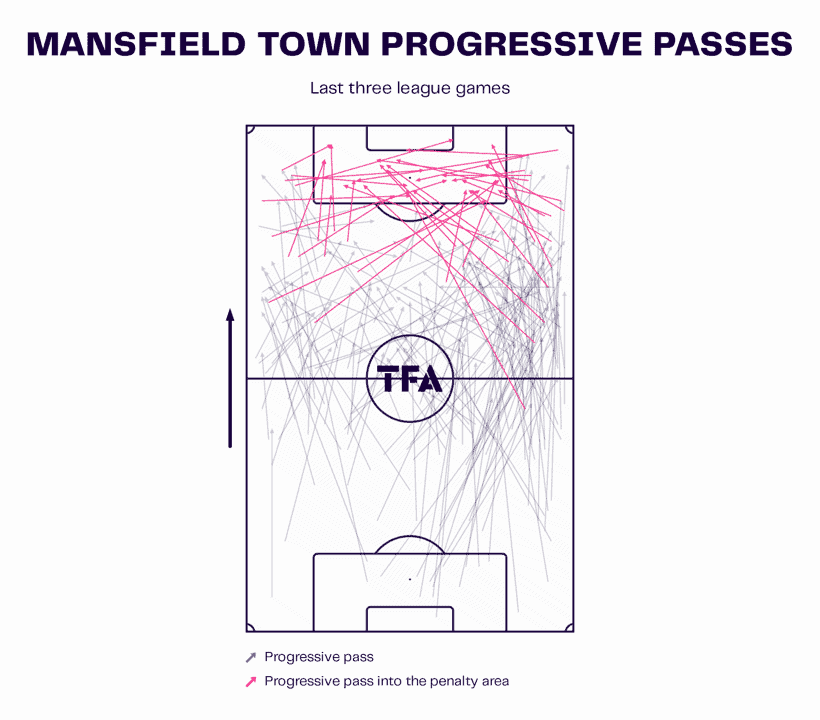
We’ll start by considering the importance of progressive passes to Clough’s tactics. As we mentioned, they currently have both the highest rate and accuracy for progressive passes in League Two, so there is an apparent ability that Clough is tapping into. Drilling into which players are responsible for that – we touched upon Louis Reed’s high attempt average, but George Maris shines in this area with an accuracy rate of 92.59% – the highest in League Two. Like Reed, Maris has several qualities that fit Clough’s tactics nicely and add an individual twist to the system.
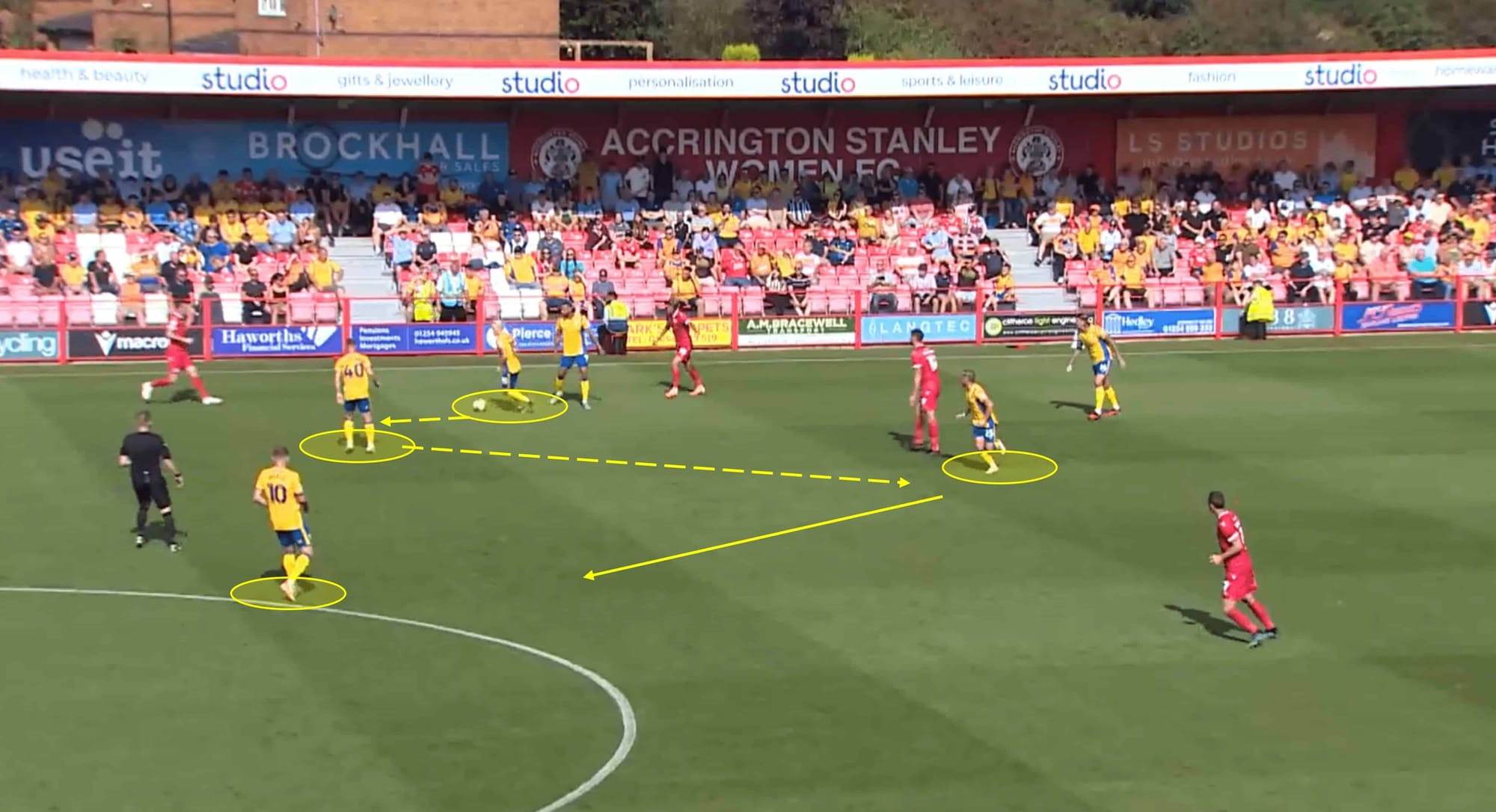
One built-in feature of the 4-3-1-2 formation is the midfield presence in your own half, giving you the chance to play passing combinations to work your way out of trouble amid a transition. At the same time, you would generally see some teams simply hit the long switch pass in this scenario; Mansfield like to utilise the close support, making it hard for the opposition to respond, eventually opening up space to attack.
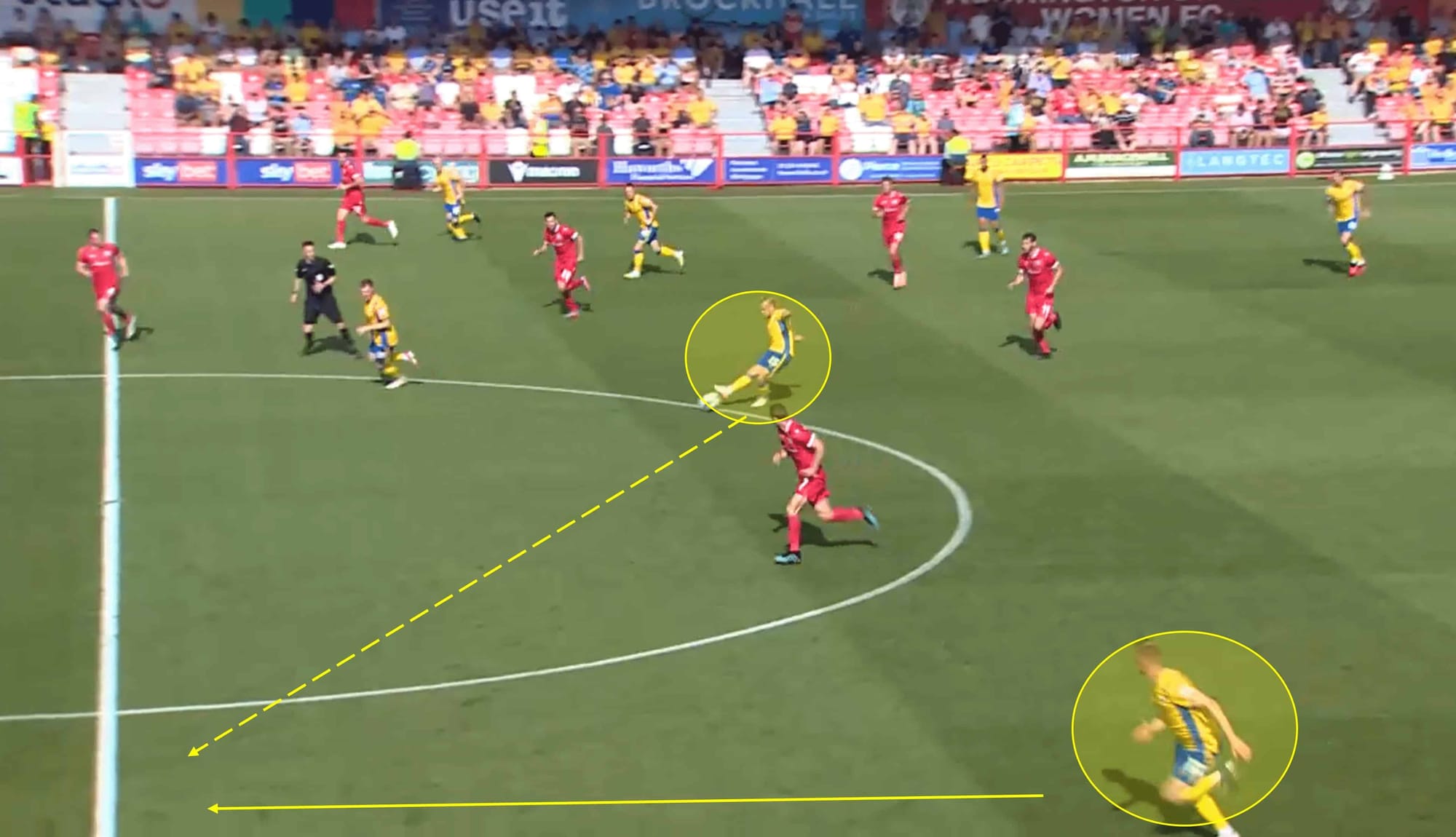
And just like that, when the time is right, a pass is punched into space – often on the opposite flank to the initial possession, resulting in the opposition scrambling back to try and combat the increased threat. This is what we meant earlier about Mansfield’s full-backs timing their attacking involvement right. If Calum MacDonald (LB) didn’t push into a higher supporting position until late in the move, Mansfield likely lose all that momentum. If he goes too early, he likely gets picked up by the opposition, severely limiting his ability to have a more significant impact.
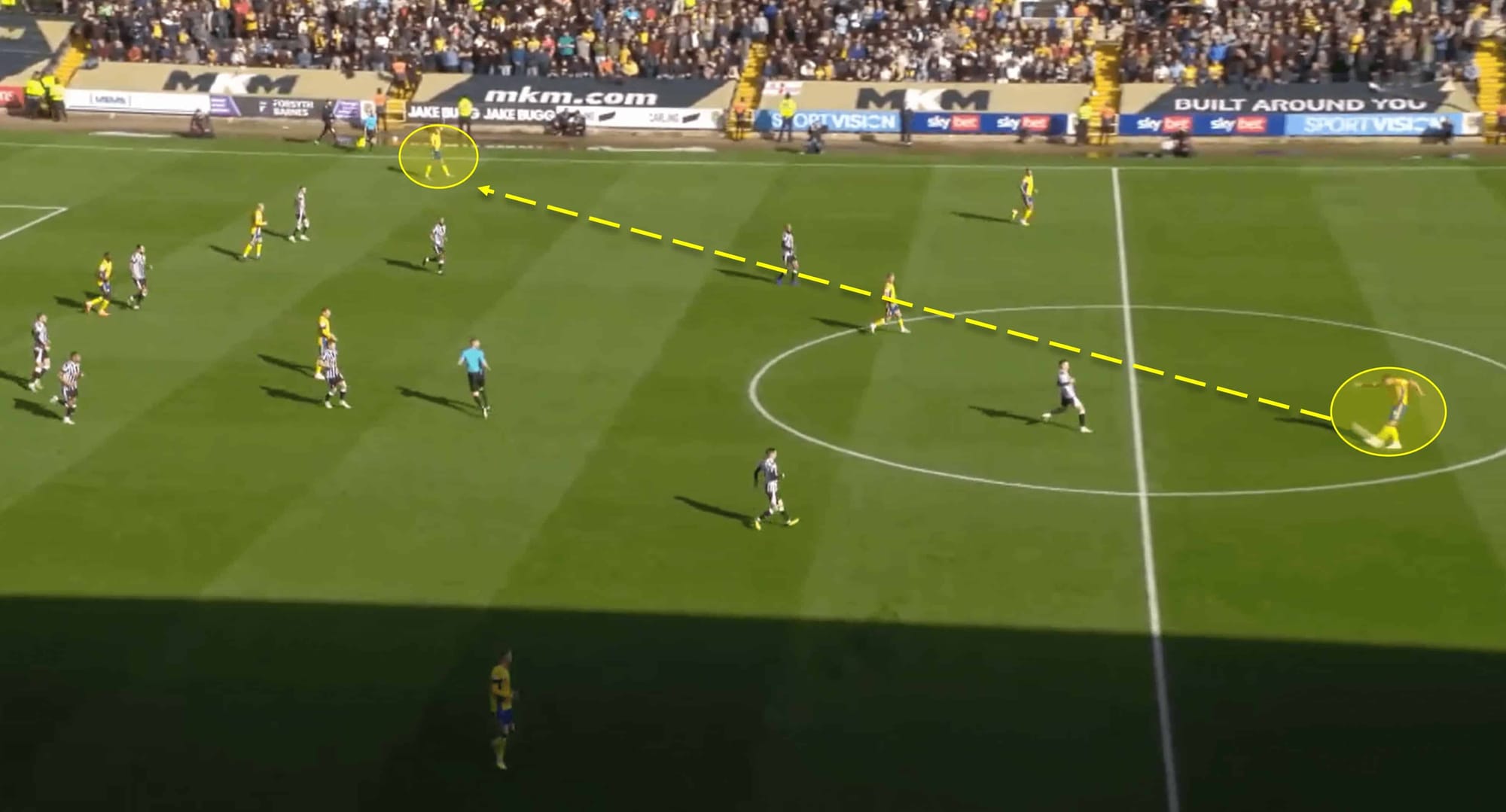
Maintaining momentum and sustaining attacking pressure is something Nigel Clough is into, and that sometimes means switching to a more direct approach to keep the opposition from pushing out of defence. When doing this, the Stags will look to hit either one of the wide areas or one of the centre forwards, as both are capable of challenging in the air. While their 55.34 long passes per 90 is just above average in League Two, their completion rate of 56.7% is the third-highest accuracy rate in the division, so while they use the direct approach somewhat sporadically, they are capable of doing so effectively.
Defending – aggressive yet regimented
While Mansfield’s attacking play holds several strengths, so far this season, their defensive performance has earned them the most plaudits. This is partly down to Clough’s side shipping just 10 goals in their opening 13 matches – the lowest tally in the league, earning themselves a reputation of being extremely hard to beat. This final analysis segment will provide an analysis of some of the most essential elements of their defensive tactics, from off-the-ball shape to executing a press.
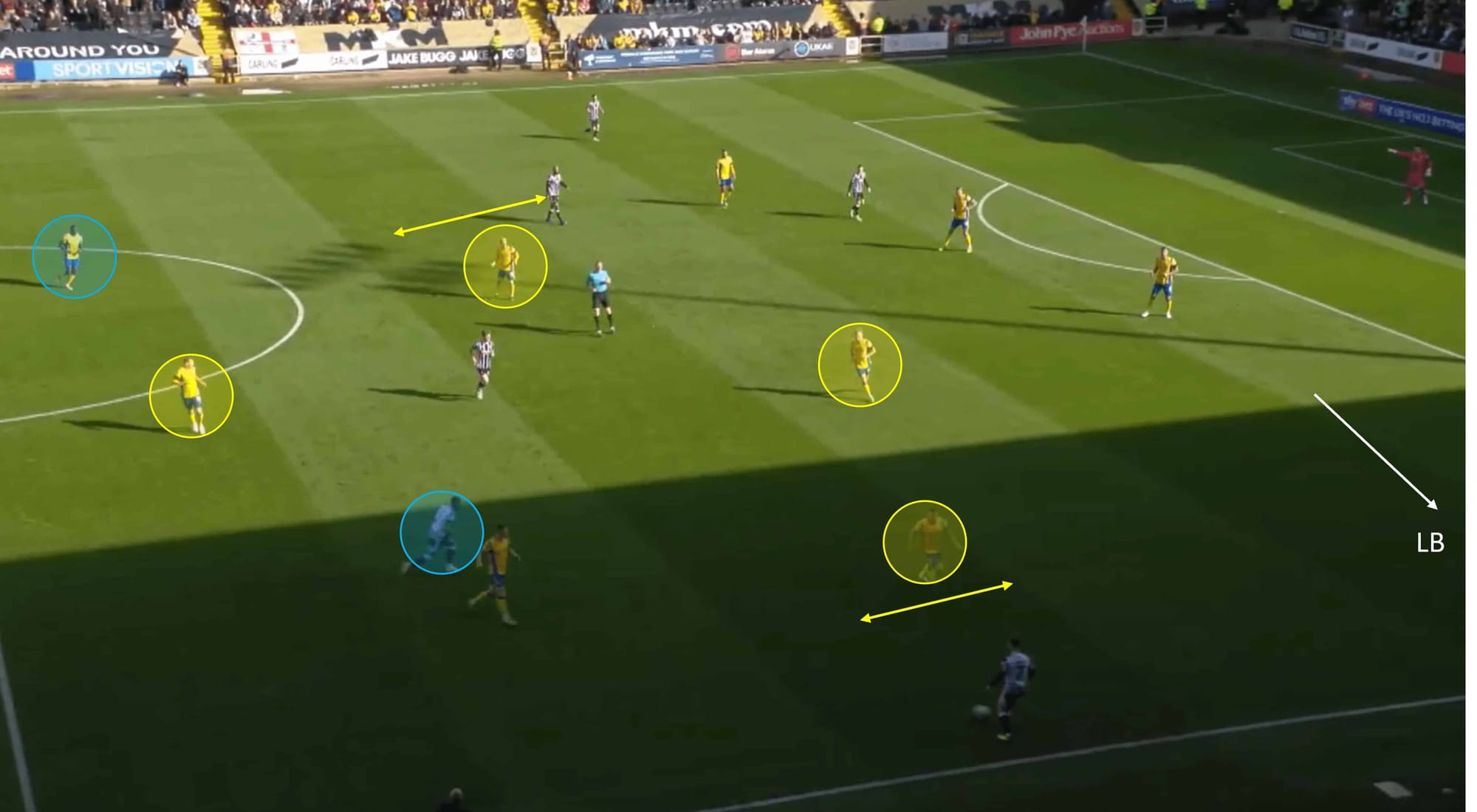
The Stags are building a reputation of being hard to beat and hard to break down, and that credit goes to Nigel Clough and the tactical discipline he has instilled within the squad. Off the ball, organisation is critical, as it is for any team, but we see some interesting positional adaptations from Mansfield.
Sitting in a mid-block, the midfield width depends on the opposition’s approach and width. The example above comes from their recent 4-1 win away at Notts County, who like to play a possession-based game, stretching the pitch – a wide approach. To combat this, Mansfield opted not to sit in a compact shape as this would just invite County to run down the flank. Instead, often, we see two banks of three, with the CFs (blue highlighted) dropping in to provide defensive assistance to the midfield unit (yellow highlighted). The spacing and general positioning from Mansfield’s midfield unit is a big part of them being a difficult side to break down.
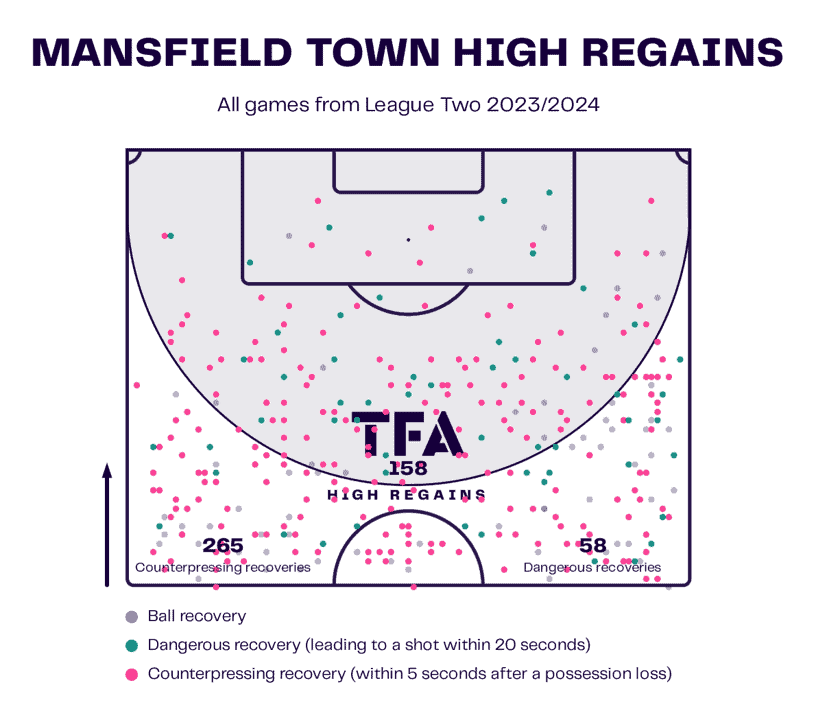
Timing is vital to Mansfield’s tactics, both in and out of possession. One of the areas they thrive in is the timing of their press, and in fact, pressing the opposition is something Clough likes his team to do. As you can see from the map above, Town are experts in counterpressing and can win the ball in high areas – we covered their ability in attacking transitions after winning the ball in these high areas earlier on. Their pressing numbers trump many teams in the league, too – their PPDA of 9.61 is the league’s sixth-best register, while their challenge intensity rate of 6.5 is the third-highest in League Two.
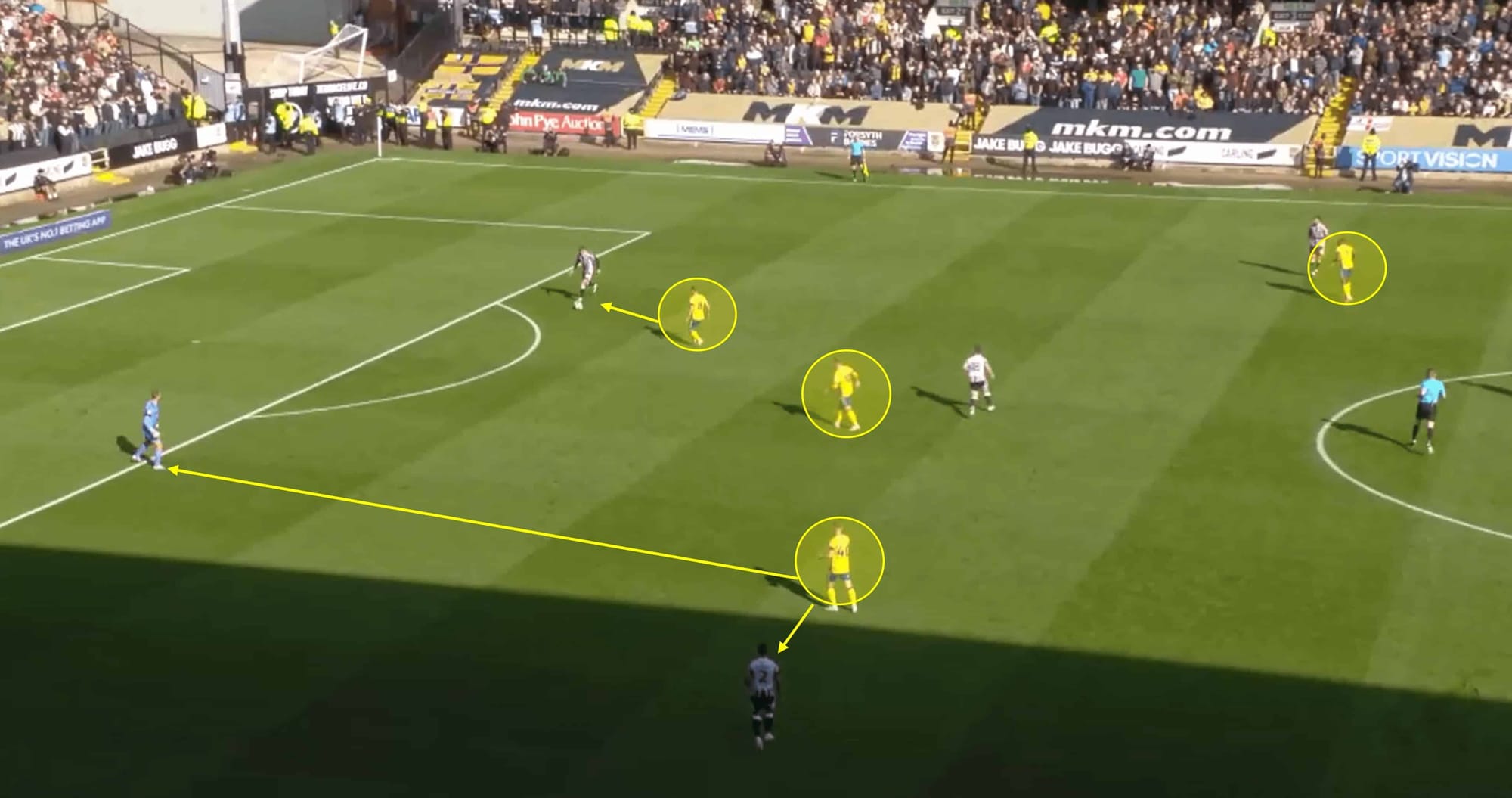
Let’s look at their pressing in the final third in more detail – expect to see that word ‘timing’ again! The two strikers often split when the Stags execute their usual pressing move, with the more attack-minded midfielder (often Keillor-Dunn) joining them to increase the pressure. Behind them, midfielders have been seen to go man-for-man to limit the opposition’s chances of playing a ball into the middle of the park.
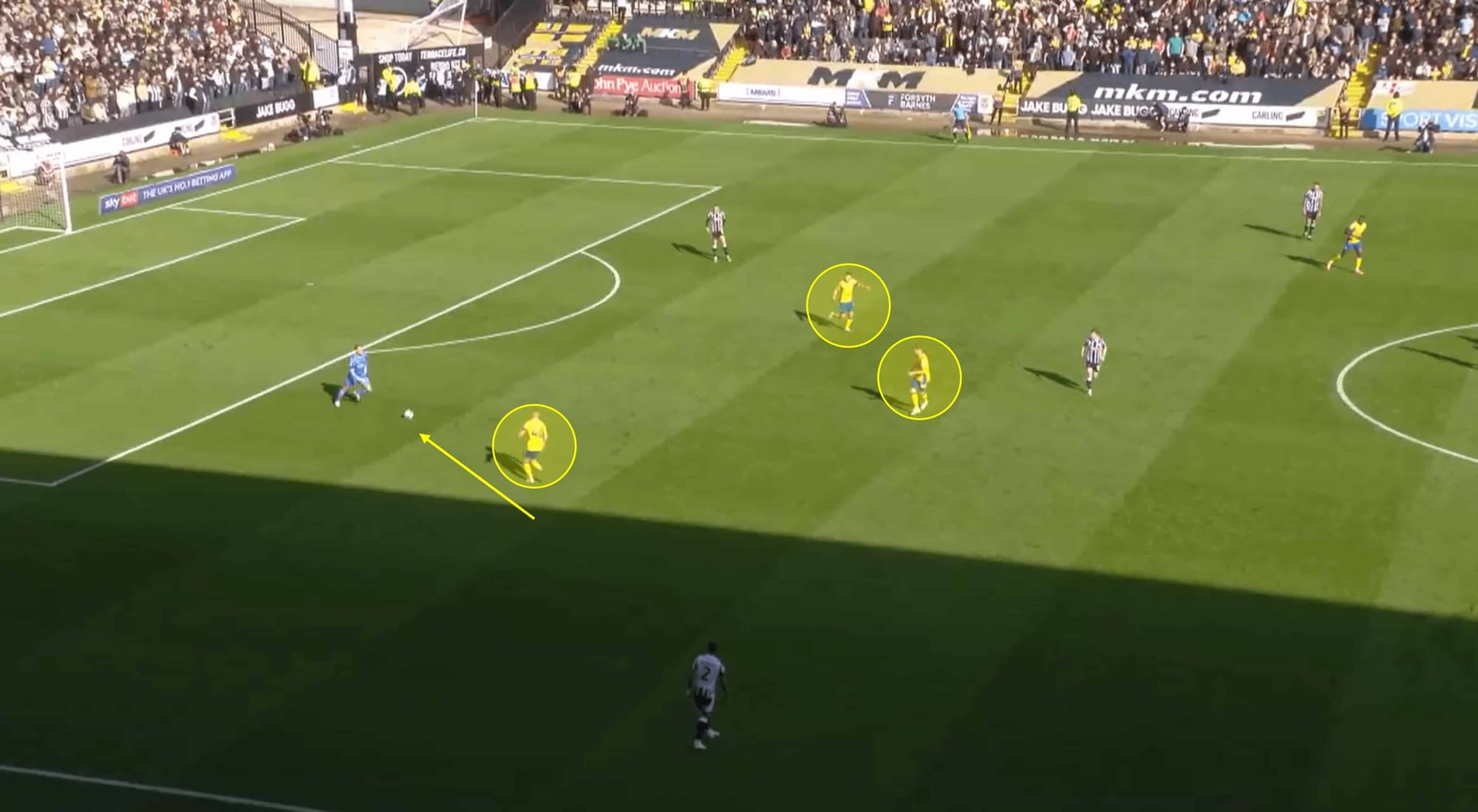
As the press unfolds, you start to see just how much Mansfield’s players really understand their roles individually and on a unit basis. The example above shows this: the opposition CB plays a pass to the GK, and the closest player immediately presses him at an angle that cuts off the passing line to the full-back. The positioning of the other two advanced Mansfield players, combined with this pressure, forces the keeper to go long, giving Mansfield a better chance of causing a turnover.
Conclusion
Truthfully, there were several other areas of strength that we could have included in this scout report – their positive numbers in 1v1s & dribbling, how they boast the fourth-highest possession average in the division, how they take more shots than any other team in the league – the list could go on. Instead, we highlighted two critical areas of their time on the ball while covering some key aspects of their defensive tactics. In a nutshell, it seems Nigel Clough is building something at Mansfield, with his vision seemingly coming to fruition this season more than ever. Expect the Stags to be amongst the top six come the end of the season!

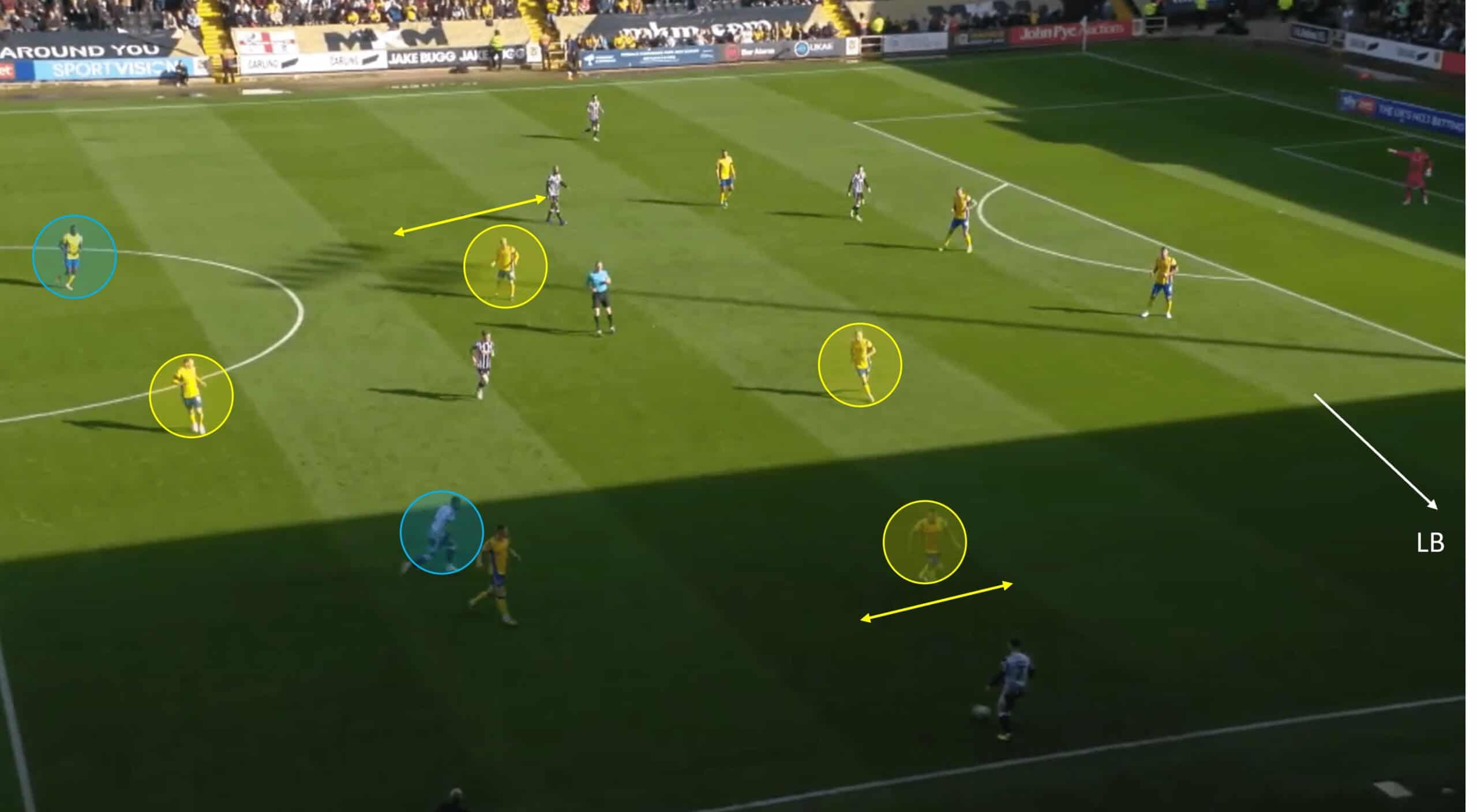




Comments